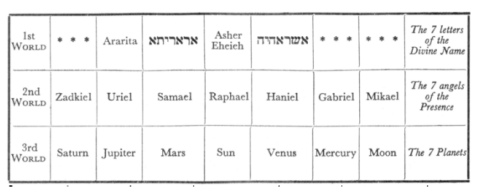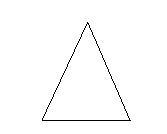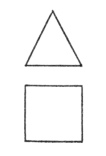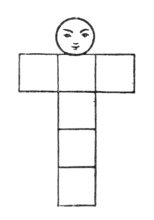
PSYCHOLOGY OF ANCIENT EGYPT
(Important Notes)
[Le Lotus, Paris, Vol. III, No. 16, July, 1888, pp. 202-206]
[Translation of the foregoing original French text.]
In No. 14 of Le Lotus [May, 1888, p. 105] an article will be found by Franz Lambert translated from the Sphinx containing the following passage, a transcription of a tablet representing the arrival of the deceased
“Here we see the deceased working in the Elysian Fields, sowing and reaping them. The barley therein is 7 ells high, the ears 3, and the straw 4. From the harvest he sets aside an offering for Hapi, the god of abundance, etc.” *
I have underlined the errors, and for this reason: in the Book of the Dead, Chap. CIX, verses 4 and 5, the deceased expresses himself as follows:
“I know this field of Aanru with an iron enclosure; its barley is seven cubits high: its ear is three cubits, its stalk is four, etc.” †
Hapi is not the god of abundance. When he is found in a ceremony where the mummy plays the chief part he is one of the funerary Genii. Hapi personifies the
––––––––––
* [This passage is quoted from the second instalment of an essay by Franz Lambert on the “Psychology of Ancient Egypt,” which originally appeared in German in the pages of the Sphinx, a magazine published in Leipzig, Germany, by Dr. William Hübbe-Schleiden. Its original title was “Die altägyptische Seelenlehre,” and a French translation thereof appeared in Le Lotus, the monthly Journal of the “Isis” Branch of the T.S. in Paris, and may be found in Vol. III, April, May and June, 1888. It contains, among other subjects of great interest, a comparison of the Egyptian and the Kabalistic divisions of man’s constitution.—Compiler.]
† [There seems to be some uncertainty about the verses of Chapter CIX which H.P.B. refers to in making her quotation. In Sir E. A. Wallis Budge’s English translation of the Theban Recension of The Book of the Dead (2nd ed., rev. and enl., 3rd impression, London, Kegan Paul, Trench, Trübner & Co., and New York, E.P. Dutton & Co., 1928), this subject is treated of in verses 7 and 8 of Chapter CIX (page 318 of the work). We quote Budge’s text, for the benefit of the students:
––––––––––
Page 56
terrestrial water, or the Nile in its primordial aspect, as Nun personifies the celestial water. He is one of the “Seven Luminous Ones” * who accompany Osiris-Sun. In Chap. XVII, verses 38 and 39, of the Book of the Dead, it says: “The Seven Luminous Ones are Amset, Hapi, Tiaumautef, Kebhsennouf, Maa-tef-f, Ker-bek-f, Harkhent-an-mer-ti; Anubis placed them as protectors of the sarcophagus of Osiris [the Sun during eclipse and at night].” Hapi, like Amset who precedes him, is a psychopompic genius (Mercury), who receives seven gifts from Osiris-Sun, perhaps really because Mercury receives seven times more light from the Sun than does the Earth.
In the celestial hierarchy of the Archangels of the presence, or “the Seven Eyes of the Lord,” Hapi and Amset correspond to Gabriel, the Messenger, and to Michael, the patron of all gulfs and promontories, who both like Hapi, personify the terrestrial water. Some of our pious friends will protest at this. They will say: Gabriel and Michael are not psychopompic gods; the latter is the Archistrategus, the commander-in-chief of the army of the Lord, the Conqueror of the Dragon-Satan, the Victor diaboli, while Gabriel is the “Fortitudo Dei” and his Messenger. Precisely. I will even add that Michael is the Quis ut Deus, if that makes them happy. That does not prevent them both from being our Egyptian Hapi and Amset in turn. Because this Hapi, this “Eye of the Sun,” its flame, is the chief “of the divine chiefs” who with six others accompanies Osiris-Sun “to burn the souls of his enemies” † and who kills the great Enemy,
––––––––––
“. . . . I, even I, know the Sekhet-Aarru of (7) Ra, the walls of which are of iron. The height of the wheat therein is five cubits, of the ears thereof two cubits, and of the stalks thereof three cubits. (8) The barley therein is [in height] seven cubits, the ears thereof are three cubits, and the stalks thereof are four cubits. . . . .”
There is no mention of Hapi in this Recension. It is therefore possible that another Recension, such as the Saitic, may have been meant.—Compiler.]
* The Seven Planetary Spirits.
† The Book of the Dead, Chap. XVII, verse 37.
––––––––––
Page 57
the shadow of Typhon-Set; in other words, the Dragon. The Catholic Church calls this septenary <cwo_greec>, vigilant guardian, because that is precisely its name in the Book of the Dead, the “Seven Luminous Ones” being the guardians of the Sarcophagus of Osiris. Look for yourself in the Marquis de Mirville’s Mémoire à l’Académie, where he boasts of it.
But the point at issue is not exactly Amset or Hapi, and we may leave Gabriel and Michael on their respective planets for a moment. The real question bears on some interesting notes by Charles Barlet. He draws the attention of the reader to “the innumerable concordances” which the aforesaid article presents with the doctrines of the Theosophists. He gives some examples but he leaves out one of the most remarkable ones. I have in mind the verses quoted from the Book of the Dead, concerning the deceased in the field of Aanru. This chapter is the most brilliant corroboration of the seven principles of man that can be found in the esoteric religion of ancient Egypt.
The reader is warned not to seek these analogies or concordances between the two systems, esoteric and exoteric, in the translations of our Orientalists. For these gentlemen are accustomed to put more fancy than truth into their interpretations. Let us rather refer to the Kabala. The septenary system in it offers us the following table:
The Seven worlds or planes of the visible kosmos

Page 58
The rest is useless. I give only the first three worlds with their Angels and their Planets corresponding to the seven divine letters. The names of the Angels, aside from the first two, are substitutes; they are, moreover, interchangeable among themselves and with the planets. Gabriel alone has remained faithful to his Mercury, although for very well-known reasons * the Church gives Jupiter to Gabriel for his planet today. Michael balances between the Sun and the Moon. But as these two planets were, in Egyptian esotericism, the Eyes of the Lord—the Sun being the eye of Osiris by day, and the Moon the eye of Osiris by night—they are interchangeable.
Starting from this, the rest will be easy to understand. The field of Aanru is Devachan. The wheat sown and reaped by the defunct, and which is seven cubits tall, represents the karma sown and reaped by the seven principles of the dead during his life. The ear of three cubits is the upper triad (Âtman, Buddhi, and the aroma of Manas) or the upper triangle: †

––––––––––
* The little scandal produced in the VIIIth Century by the Sorcerer-Bishop Adalbert of Bavaria who compromised that poor Uriel.
† Readers who have carefully followed the teaching given in Le Lotus will easily comprehend all these things and those to follow; as for others we may advise them to read Le Lotus from the beginning (Editor, Le Lotus).
––––––––––
Page 59
The four cubits (the stalk or straw) are the four lower principles (kâma-rûpa, the astral body, the vital principle, the vital man), represented by the square.

For man has always been shown thus in geometrical symbols:

In Egypt it was the symbolic tau, the ansated cross:

This is the representation of man. The circle or handle which surmounts the tau is a human head. It is the man crucified in space of Plato, or the Wittoba of the Hindus (See
Page 60
Edward Moor’s Hindoo Pantheon).* In Hebrew the word man is rendered by Anosh, and, as Seyffarth says:
“It represents, as I now believe, the skull with the brains, the seat of the soul, and with the nerves extending to the spine, back, and eyes or ears. For the Tanis stone translates it repeatedly by anthropos (man), and this very word is alphabetically written (Egyptian) ank. Hence we have the Coptic ank, vita, properly anima, which corresponds with the Hebrew <cwo_hebrew>, anosh, properly meaning anima. This <cwo_hebrew> is the primitive <cwo_hebrew> for <cwo_hebrew> (the personal pronoun I). The Egyptian Anki signifies my soul.”
It is curious that this Hebrew equivalent, Anosh, for “man,” by Mr. Seyffarth, reads numerically † 365—1, which could be intended to mean either 365 + 1=366, or 365—1=364, or the time phases of the solar year, thus shadowing forth the astronomical connection.‡
We see, then, that the solar year, or rather the number of its days, is found to correspond with the septenary man, or twice septenary, for we have the psychic man of seven principles or etheric planes, and the physical man whose division is the same. This makes 14 and corresponds to the three digits 3, 6, 5=14. Let us see if the nocturnal eye of Osiris, the Moon or the symbol of the Hebrew Jehovah, corresponds to that. It is said in an unpublished and very Kabalistic manuscript:
“The Ancients have always made mysterious use of the numbers 3 and 4, composing the number 7. One of the chief properties of this number thus divided, is that, if we multiply 20612§ by 4/3 the product will give us a base for the determination of the mean revolution of the Moon, and if we multiply this product again
––––––––––
* [The Plate in Edward Moor’s work referred to is reproduced in Volume VII, p. 296, of the present Series.—Compiler.]
† We remind our readers that in the Kabala we have to take notice of the numerical value of the letters: : or sh equals 3, & or o equals 6, etc.
We ask pardon from Kabalists for this rather naïve note, but we are doing our best to make it clear to readers who are novices in such matters (Editor, Le Lotus).
‡ [J. R. Skinner, Source of Measures, p. 53.]
§ This number is the numerator of 20612/6561 which gives B, the relation of the diameter to the circumference (Editor, Le Lotus).
––––––––––
Page 61
by J we shall have a base to find the exact period of the mean solar year.” *
Now, examine well the esoteric ansated cross of the Egyptians. The cross is the unfolded cube whose six faces give us the septenary, for we have 4 on a vertical and 3 on a horizontal line, which makes 7, the middle space being common to both lines. The 4 and the 3 are the most esoteric numbers, because 7 is the number of life, the number of nature herself, as it is easy to prove in relation to the vegetable and animal kingdoms. 3 is spirit; 4 is matter. But in the symbol in question which is purely phallic, since it represents living and septenary man, it is the 4 which corresponds to the male line; it is, in fact, the Tetragrammaton, the Tetraktys on the lower plane, “the heavenly Man” or Adam-Kadmon, the male-female (i.e., Jah-vah or Jehovah); or again Chochma and Binah (wisdom and intelligence, the divine Hermaphrodite), on our cosmic and terrestrial plane. The horizontal line of the three faces of the cube is the feminine principle. It is Jehovah-Eve of the pre-Adamic race, which, like Brahmâ-Vâch, is separated into two sexes. This Eve which was the Sophia or Holy Ghost † of the Gnostics, gave birth to Cain-Abel, the male and the female on earth of the race of Adam. (See my notes on Cain and Abel in The Secret Doctrine.) ‡
––––––––––
* [From an hitherto unpublished MS of J. Ralston Skinner in the Adyar Archives, comprehensive information about which may be found in Vol. VIII, pp. 219-20 (Note 6) in the present Series. —Compiler.]
† See “The Apocryphal (?) Gospel of the Hebrews,” where the author makes Jesus say: “My Mother, the Holy Ghost, took me by a hair of my head and transported me unto Mount Thabor.” I translate from the original. [Vide Compiler’s footnote on p. 54.]
‡ [It is somewhat uncertain what particular passages in her magnum opus H.P.B. had in mind in making this statement. It should be borne in mind that when this article was written, The Secret Doctrine had not yet been published, and it may well be that further changes were made in the MSS of this work after July, 1888. However, the latter portion of page 127, in Volume II of The Secret Doctrine bears a close analogy to the subject under discussion. Consult the Index of this work for the many other references to Cain and Abel.—Compiler.]
––––––––––
––––––––––
Page 62
Once in the other world, the principles constituting the defunct separate thus: 1, the vital principle leaves the body; 2, the body dissolves; the astral spirit evaporates with the last physical atom. Of the lower quaternary, there remains the Kâma-rûpa, i.e., the périsprit of the human animal. As for the upper triad, it leaves the lower quaternary; and the Spirit with its vehicle, the divine Soul, accompanied by the Spiritual aroma of manas, reunited in the Unity of the immortal Ego, are found in the happy state of Devachan. Of the inferior part of the manas (human soul), the périsprit (animal soul) preserves just enough instinct to seek out and vampirize mediums. Its destiny is to evaporate later on. Until then, it exists merely on the life and intelligence of the living (mediums and believers) who are weak enough to allow themselves to be possessed; it is thus but a miserable borrowed life.
And this is what is meant by the 3 cubits of the ear and the 4 cubits of the stalk of the wheat that grows in the Fields of Aanru.
H. P. BLAVATSKY.
[Most valuable information, not otherwise easily accessible, concerning occult sciences in ancient Egypt, may be found in two other essays from the pen of Franz Lambert: “Hypnotismus und Electrizität im alten Ägypten” (Sphinx, Vol. V, January, 1888; trans. into English in The Theosophist, Vol. XIV, December, 1892, pp. 161-171, with interesting drawings), and “Weisheit der Ägypter” (ibid., Vol. VII, Jan., Feb., April and June, 1889). The article of Georgia Louise Leonard, in the Open Court (September and October, 1887), on “The Occult Sciences in the Temples of Ancient Egypt,” is also full of interesting data.—Compiler.]